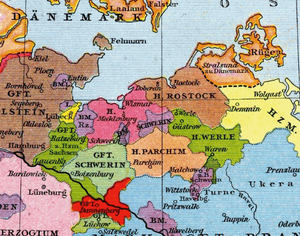Mecklenburg main state division

In its history, the Mecklenburg state has repeatedly been divided into various partial rulers (dominions, duchies, grand duchies). Modern state historical research distinguishes three main state divisions of Mecklenburg :
First division of Mecklenburg mainland
The first Mecklenburg main division of the state in 1234 led the grandson of Prince Henry I. Borwin by. The four dominions (principalities) Mecklenburg , Parchim-Richenberg , Werle and Rostock were created by way of real division .
- Here was John the rule of Mecklenburg with the castle Mecklenburg, Dassow, Klutz, Bresen (Grevesmühlen), Gadebusch, Poel, Ilow, Bug (Bukow), Brüel and Kussin (Neukloster);
- Pribislaw received the rule of Parchim with Parchim, Sternberg, Brenz (Neustadt), Ture (Lübz), Quetzin (Plau-Goldberg);
- Nikolaus received the rule Werle with Werle, Bisdede (Güstrow), Teterow, Laage, Krakow, Malchow, Vipperow (Röbel), Turne, Liese and later from Pomeranian property Dargun, Malchin, Tucen and Gödebant-Tützen and Gädebehn (Stavenhagen), Sone -Schlön (Waren / Müritz) and Wustrow (Penzlin);
- Heinrich Borwin III. received the rule of Rostock with Kessin (Rostock), Kröpelin, Doberan, Ribnitz, Marlow, Sülze, Tessin and later Gnoien and Kalen.
The first main division of the country lasted until 1471, when the four parts were reunited under Duke Heinrich the Fat by inheritance .
Second Mecklenburg main state division
During the Second Mecklenburg main land partition sharing agreement emerged after driving Holzer in 1621 through asset split the (partial) duchies of Mecklenburg-Schwerin and Mecklenburg-Güstrow . This subdivision already existed with a few interruptions after the death of Heinrich des Dicken in 1477 and again from 1520 (according to the Neubrandenburg house contract ), but only in the form of an assignment of offices for sole usufruct, while the supervision of various cities in both parts of the country and all state affairs also remained common.
The division was not based on the origins and historical context of the areas. The decisive factor was the goal of dividing territories and income as evenly as possible. In order to achieve this, for example, the westernmost office Boizenburg was assigned to the Güstrow part of the country because of its Elbe tariff, because Schwerin already had the Elbe tariff in Dömitz. As a result, Adolf Friedrich I received the Mecklenburg-Schwerin region, his brother Johann Albrecht II the Mecklenburg-Güstrow region. The city of Rostock with Warnemünde, the four state monasteries Dobbertin , Malchow , Ribnitz and the monastery of the Holy Cross in Rostock remained together. The court and regional court, the consistory , the state parliament, the border disputes, the costs to the Reich Chamber of Commerce and others also remained together.
Third main division of Mecklenburg
The Third Main Division of Mecklenburg divided the inheritance in Mecklenburg-Güstrow into the (partial) duchy of Mecklenburg-Schwerin, which remained with changed territory, and the newly formed (partial) duchy of Mecklenburg-Strelitz, based on the Hamburg settlement of 1701 . These territorial estates existed until the end of the monarchy as limited autonomous parts of the Mecklenburg state , from 1918/19 as sovereign free states in the association of the German Reich. The reunification of the two Free States took place in 1934 under National Socialist pressure.
literature
- G. Duncker: The second Mecklenburg main division . In: yearbooks of the association for meckl. History and Antiquity 73. Schwerin 1908, pp. 290ff.

